
Operation: Saint-Leu-d’Esserent, France
Date: July 7/8 1944 (Friday/Saturday)
Unit: 106 Squadron - Motto: Pro Libertate (For Freedom).
Squadron Badge: A lion sejant, rampant, holding a banner charged with an astral crown. Based on the crest of the County Borough of Doncaster, the squadron being stationed near there at the time of adopting the badge.
Type: Lancaster I
Serial: ME789
Code: ZN-B
Base: RAF Metheringham, Lincolnshire
Location: Abandoned near Gournay-en-Bray, France
Pilot: F/O. Gordon Stanley Mather J24129 RCAF Age 30 PoW No 4796 Camp: Stalag Luft 1 Barth, Western Pomerania - L1 (1)
Fl/Eng: Sgt. Leslie John Lucas 1873332 RAFVR Age 23 Evaded but later captured - PoW No. 8103 Buchenwald Concentration Camp (2)
- helped by Perdereau network and later captured in Paris with C. W. Nuttal (LV790) during a check up.
Nav: F/O Donald Angus ‘Don’ Evans R79860/J20330 RCAF Age 25 Evaded and returned safely to UK (3)
(The RAF Loss Card records his service number as J27508)
Air/Bmr: F/O John S. ‘Jack’ Kingston J22365 RCAF Age ? PoW No. 2068 Camp: Stalag Luft Sagan and Belaria L3, Milag-Marlag Nord-Oflag L (4)
W/Op/Air/Gnr: F/Sgt. William Stewart 1076921 RAFVR Age ? PoW No. 492 Camp: Stalag Luft Bankau, Silesia, Germany (now Bąków, Opole Voivodeship, Poland) - L7 (5)
Air/Gnr: Sgt. John C. Crawford R221932 RCAF Age 21 - Evaded and later captured - PoW No. 8080 Buchenwald Concentration Camp then Stalag Luft Sagan and Belaria L3 and Stalag Luft Moosburg L7A (6)
Air/Gnr: Sgt. William A. Waldram R251277 RCAF Age ? Evaded, helped by Perdereau network and later captured in Paris - PoW No. 8118 Buchenwald Concentration Camp then Stalag Luft Sagan and Belaria L3 (7)
We appeal to anyone with further information and/or photographs to please contact us via our HELPDESK
INTRODUCTION
The catastrophic Nuremberg raid of 30/31 March 1944, marked the end of the Battle of Berlin and Air Chief Marshal Harris’ strategic aspiration of bombing the Nazi regime into surrender. Subsequent target selection would be decided by General Dwight Eisenhower and the senior staff of the Supreme Headquarters Allied Expeditionary Force (SHAEF), and directed towards the invasion and liberation of German-occupied Europe. These targets included railway yards, military camps, ammunition depots, explosive and armament factories and finally radio and radar installations and coastal gun batteries. This was a morale booster for Bomber Command crews as they were now attacking military targets and not German cities. This resulted in a shift from area to precision bombing with accurate marking by Pathfinder crews and a designated Master Bomber to minimize civilian casualties.
In addition to pre-invasion targets the Allied commanders were confronted with the escalating threat to London and south England of V-1 terror weapons. The launch sites and storage facilities were priority targets, often requiring repeated attacks in optimal weather conditions necessary for accurate marking and bombing but also ideal for night fighter infiltration into the bomber stream.
The July 7/8, 1944 bombing attack on the V-1 storage site at Saint-Leu-d’Esserent would exemplify the cost to Bomber Command aircrew in finally neutralizing this threat.
REASON FOR LOSS
The following account (in bold) is related by Garth Evans the son of ME789 navigator, Don Evans with additional notes by Aircrew Remembered researcher Roy Wilcock.
'My father came from a very poor background. His father was a subsistence farmer in northern Saskatchewan and he was the youngest of 3 sons, second youngest of 6 children.
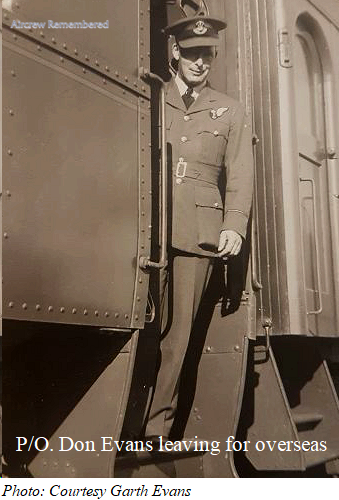
My grandfather was in his 70s and told my father if he joined the air force he would have to sell the farm as he was too old to work it on his own. Nevertheless, he joined the RCAF on November 30, 1940. He said he wasn’t a patriot but did so in order to improve his life.
He was trained as an air frame mechanic and stationed at a number of bases throughout Canada, I recall him mentioning Saint Thomas and Moncton. He achieved the rank of Sergeant and sometime in 1942 he volunteered for air crew training.
He was first sent to train as a pilot but washed out and then was sent to train as a navigator in Edmonton. He qualified as a navigator and was promoted to the rank of Flying Officer. He said the top half of the class were made Flying Officers and the bottom half Sergeants and that he was 2 above the middle.
In October 1943 he was sent to Britain on the small French liner, Louis Pasteur. They landed in Motherwell in Scotland near Glasgow. Around this time he befriended Jack Kingston, the bomb aimer on ME789. Kingston was from Toronto.'

'He trained in Scotland first on two engine aircraft and then was converted to four engine aircraft. At some point, probably when they were converting to four engines, a group of perhaps 20 crews were assembled and told to form themselves into aircrew. My father knew Kingston and they proceeded to assemble themselves into the crew that they would fly with operationally. That is except Lucas, the Engineer, who was added later. This was standard practice since the Engineer was kind of a poor man’s second pilot. They then completed their training and were assigned to No. 106 RAF Squadron on approximately April 1, 1944. My father flew 7 operational missions, the last being the one where he was shot down on the evening of July 7/8, 1944.
106 Squadron was based at Metheringham in Lincolnshire. There were 3 squadrons based there. When my son visited the base 20 years ago with his mother, Lucas the engineer met them there. Apparently he lived nearby and my son Keith must have contacted him.'
Gordon Mather first flew on operations on the night of 27/28 May. Flying as second dickey with F/O. G. N. Marchant, one of ten 106 Squadron aircraft detailed to bomb the railway yards at Nantes
On 2/3 June he flew as Captain of Lancaster ND331 with his own crew on a raid on the Gun Battery at Marquise, Pas-de-Calais.
On 5/6 June he and his crew were detailed for an attack on the Gun Battery at Saint-Pierre-du-Mont ,Normandy, again flying ND331. The next night it was ND331 again for a raid on Bridges at Caen.
The crew did not fly on ops again until the night of 19/20 June when they were detailed for a raid on the Watten Constructional Works flying LL975. 16 Lancasters took off but within 10 minutes of setting course were recalled due to the prospect of a dangerously low cloud base for the return.
On the night of 21/22 June and again flying LL975 they were one of 20 106 Squadron crews that took part in a raid on the Synthetic Oil Refineries at Gelsenkirchen (Buer). Two of the aircraft failed to return.
Their next operation was not until 29 June when they were allocated Lancaster JB663, one of 14 despatched for a daylight raid on the Flying Bomb Platform at Beauvoir. For reasons unknown, navigator Don Evans was replaced by P/O. A. E. Power on this operation.
On the night of 4/5 July the crew was called upon once more, the target being the Flying Bomb Dump at Saint-Leu-d'Esserent. The Squadron provided 16 aircraft towards the total force of 187 Lancasters for the attack. Two of the 106 aircraft failed to return and a third was severely damaged by a fighter, the mid-upper gunner being killed.
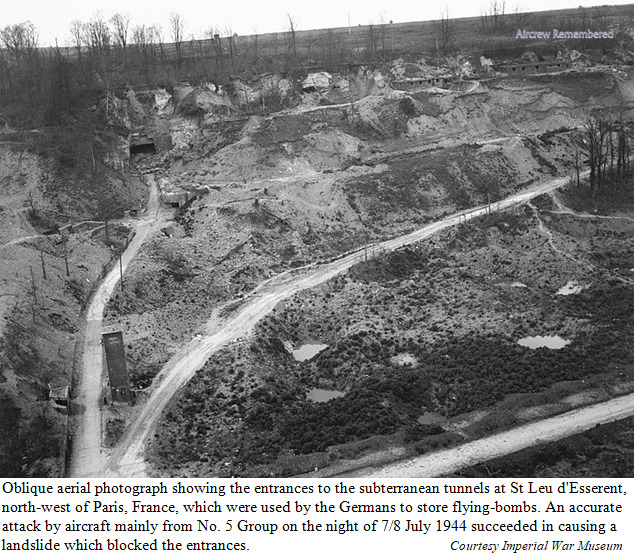

'The target on July 7-8 was [once more] the mushroom caves at Saint-Leu-d’Esserent, 50 miles north of Paris, where the Germans had stored 3,000 V1 flying bombs. V1s were the highest priority target at the time and Bomber Command sent 208 Lancaster bombers to get them. Bomber Command had attacked the caves two nights earlier but missed, so the Germans were alerted and were waiting for them to try again. Casualties were high, 29 out of 208, and in my father’s squadron 5 out of 16, with 3 of the 5 blown out of the air and my father’s plane and one other were damaged over the target and unable to stay airborne. I remember my father telling me that he saved Stewart the upper gunner’s life because he froze in the escape hatch ahead of him and he booted Stewart in the ass and out he went. I believe my father was the second to last man out and he said they were very low, perhaps only 1,000 feet, as his chute had just opened when he hit the ground. He hurt his leg when he landed. He said Mather, the pilot, was so low when he jumped out that he broke his back when he landed. My father described Mather as a fanatic who refused to give up and was still trying to fly the plane back to England after the situation had become hopeless. He said they were attacked by a night fighter over the target just after releasing their bombs. He said he thought the night fighter fired vertical cannon shells into their left wing catching it on fire and knocking out two engines. My father landed near the town of Gournay about half way to the coast from the target. I met John Crawford, the rear gunner, 30 years ago. He was an American and lived in Tacoma. He said he bailed out earlier and came down near Beauvais.'
Notes on the RAF Loss Card for ME789 state that William Waldram was 'Put out on static line. Wounded in combat' and Gordon Mather stated that 'Both port engines stopped but a fire broke out later at the rear end of the fuselage and the order to abandon was given'
'The entire crew survived but they were all POWs except my father. The crew resembled the United Nations. My father and Kingston were Canadians, Lucas was English, Mather was from the Bahamas, Crawford was American and Stewart was Scottish.
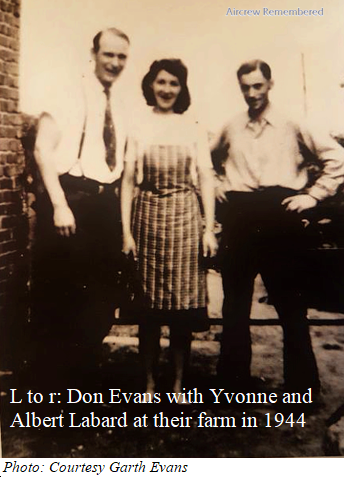
My father said he landed in a wooded area near a road and that there was a ditch nearby. He said they were told to bury their parachutes so he put it in a ditch and kicked dirt over it. He then went farther into the woods to hide. He said he thought he heard the Germans going by on the road looking for survivors and that in the early morning he heard an anti-aircraft gun firing nearby and was very happy that the war was over for him and that he wouldn’t have to fly anymore. He said his leg was hurting quite a bit and in the afternoon he realised he needed someone to help him. He got out on the road and started walking believing that someone would come along eventually. He said he didn’t much care at that point whether it was the Germans or the French Resistance.
After a while two girls rode by on their bicycles, he thought they were about 18. He said they had to know what he was as he was still wearing his uniform. He said one girl circled back and the other girl kept on going. The girl that circled back rode around him and said in English 'Follow me'. She rode ahead and stopped every now and again to wait for him to catch up. He was limping and couldn’t walk very fast. Eventually they came to a house and she said 'Wait here'. She went to the house and came back with an English lady who was married to a Frenchman. She was the cell leader and took my father in. She farmed my father out to a number of places, most of the time on the Labards’ little farm until the area was liberated by the British Army on September 3, 1944.
When I went to Gournay with my father in 1989 we discovered that the Gestapo had killed the cell leader lady.
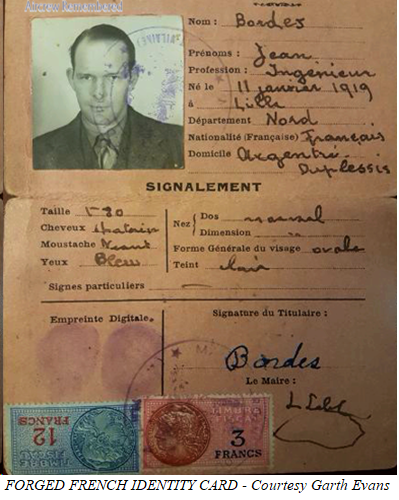
My father identified himself to a British Army Lieutenant who sent him back to the beach where he was flown to London and within 48 hours was being questioned by British Army intelligence.
My father told me the gunners bailed out over Beauvais, met up on the ground, made contact with the Resistance and were taken by truck to Paris to be passed on and escape to Spain. However, the cell had been turned and instead they were delivered to Gestapo Headquarters in Paris and from there taken to Buchenwald Concentration camp as 'suspected spies.'
Garth Evans.
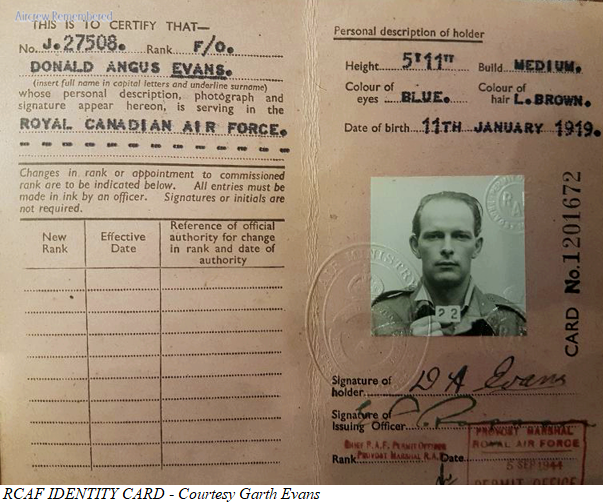

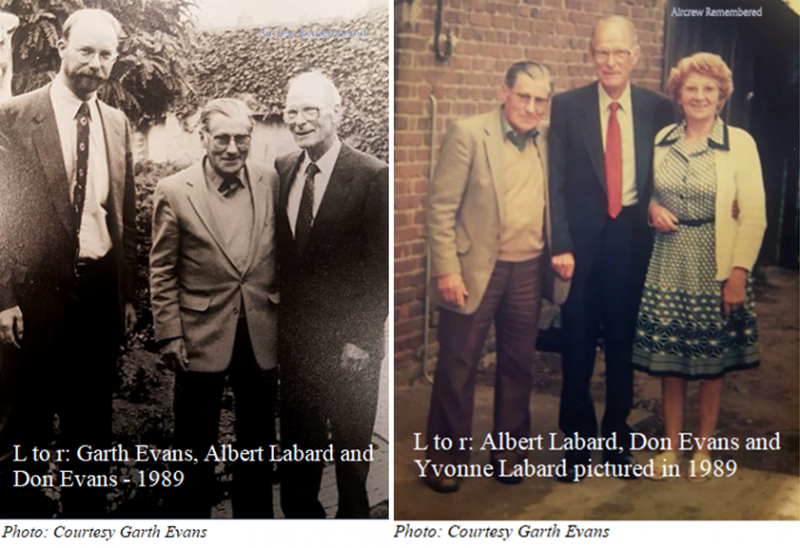
THE FATE OF THE OTHER CREW MEMBERS
Gordon Mather, Jack Kingston and William Stewart were captured soon after landing and remained prisoners of war until the end of the war. Gordon Mather was captured at Villy le Bas on 8 July 1944 and held in solitary confinement and questioned orally, first at Brussels and then at Oberusel Nr. Frankfurt. He was then sent to Stalag Luft 1 at Barth in Western Pomerania arriving on 27 July 1944. He was held at Stalag Luft 1 until being liberated by Russian forces on 1 May 1945.
John Lucas, John Crawford and William Waldram evaded for a few weeks but all three were captured and imprisoned along with other downed airmen from Great Britain, United States, Australia, Canada, New Zealand and Jamaica at Fresnes Prison outside Paris.
These captured airmen were given the name 'Terrorflieger' (Terror Flyers), and were not given a trial. The German Foreign Office however, expressed concern about shooting prisoners of war but suggested that enemy airmen suspected of such offenses be denied the legal status of PoWs. Following this advice, the Gestapo and Security Police informed these captured Allied airmen that they were criminals and spies and would be treated as such. Using this justification, 168 Allied airmen were taken by train – in overcrowded cattle trucks – from Fresnes to Buchenwald concentration camp. After five days in the boxcars, they arrived at Buchenwald on 20 August 1944.
Buchenwald was also administered by the Gestapo but following the discovery of this breach of the Geneva Convention by the Luftwaffe, Reichsmarschall Hermann Goering, head of the Luftwaffe, ordered the airmen to be put in a prisoners of war camp: they were accordingly transferred to such on 19 October 1944
John Crawford's Buchenwald record card
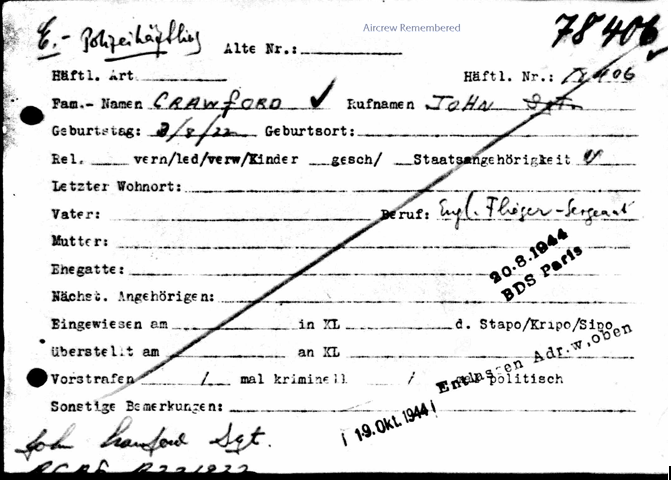
In the following poem written by the rear gunner, William Waldram, KLB is an abbreviation for Konzentrationslager Buchenwald
A Reflection
by Willie Waldram
I'll think of you dear KLB
Again some future day,
When the world is gay and free
And I am so far away.
Of those long appells in pouring rain
With neither boots nor shoes,
And the SS guards who counted us
Hitting whom they choose.
When I bounce my children on my knee
I'll think of the Gypsy kids,
Who, instead of wearing ball and chain,
Should have been wearing bibs.
When I Lay in my cosy bed at night
I'll think of your hard boards,
With a single blanket to cover us,
And fleas and lice in hordes.
Ironically, I'll think of how
You took our dog-tags from us,
'Nix soldat-civil' you said,
Smiling fanatically at us.
Yes, you gave us soup and enough black bread
To etch out a mere existence,
Enough to keep us wanting more
And weaken our resistance
How two of our number lost their lives
For lack of medical aid;
You wouldn't even give them food
To help save them from the grave
And then: after eight weeks spent in your filthy soul,
Which seemed to me like years,
The Luftwaffe came, took us away,
I felt like shedding tears
And so to all you Konzentrators,
A toast I offer thee;
Here's wishing you a happy life,
And to Hell with KLB
SUMMARY OF EVENTS
On 4 and 4/5 July 1944, two attacks were carried out on the flying bomb store in a large cave at Saint-Leu-d’Esserent: 17 Lancasters, 1 Mosquito and 1 Mustang of 617 Squadron without loss, followed by 231 Lancasters and 15 Mosquitos, losing 13 Lancasters to night fighters. The scene was set.
On the evening of 7/8 July 1944 Bomber Command detailed a total of 634 sorties with 34 aircraft failing to return (5.3%):
ST-LEU-D’ESSERENT - 208 Lancasters and 13 Mosquitos attacked the flying-bomb storage dump in a group of tunnels (formerly a mushroom farm). Bombing was accurate on the tunnel mouths and the approach roads blocking access to the stored flying bombs. German night fighters accounted for 29 Lancasters and 2 Mosquitos, 14% of this force. 106 Squadron was mauled with 5 of 16 of its Lancasters failing to return!
VAIRES- 123 Lancasters and 5 Mosquitos carried out an accurate raid on the railway yards without a loss.
SUPPORT AND MINOR OPERATIONS - 106 aircraft on a diversion almost to the Dutch coast, 7 Mosquitos dropping ‘spoof’ markers supporting the Saint-Leu-d’Esserent raid, 32 Mosquitos to Berlin and 9 to Scholven/Buer, 48 aircraft on R.C.M. sorties or Resistance operations and 83 Mosquito patrols. 2 Mosquitos and 1 Resistance aircraft lost.
One of the aircraft and crews lost on the Saint-Leu-d'Esserent raid was captained by W/C William Inglis Deas the Officer Commanding 630 Squadron. The story of this loss, including more comprehensive details of the raid can be seen on the Aircrew Remembered Archive Report dedicated to Lancaster ND688 LE-R. The report also includes an enthralling first-hand account by F/O. Walter Upton, the sole survivor of the crew which would seem to discount the previously held belief that ND688 was shot down whilst homebound at 0136 hours.
NIGHT BOMBING ATTACK ON CREIL (SAINT-LEU-D’ESSERENT)
Theo Boiten in Nachtjagd War Diaries, Volume Two provides a chilling account of this raid from a different perspective.
The German controllers suspected a bombing attack in the Paris area and concentrated virtually their entire night fighter force around two beacons in the vicinity of St. Leu. Contributing factors included clear moonlight conditions. It was the start of one of the fiercest air battles fought over France in WW II. By 00.45 hours the bomber stream was engaged over the Nachtjagd assembly points northwest of Paris. One of the Nachtjagd pilots expressed disbelief that the bombers came in spite of perfect night fighter conditions!
Six heavies were shot down over the short final leg to the target and the frequency increased exponentially as the marker flares were put down over the target at 01.00 attracting the night fighters, arriving in force at 01.15. Five bombers fell on the bombing run and over St. Leu. The fighting peaked during the bomber’s return flight, with 20 heavy bombers going down in as many minutes before reaching the French coast. Lt. Jung reported visual contact with 26-30 heavies at one time, claiming two in the Paris-Creil area!
Theo Boiten has provided the following Nachtjagd crews as the most likely claimants for the loss of ME789 and ND688: I have for ME789 in the NCA series:
Maj. Günther Vowinckel: 1 Stab I./NJG4 Lancaster Rouen-Gisors area (TC-TD): 3.200 m. 01.30 44 Sqn Lancaster ME634, 49 Sqn Lancaster LL976, 50 Sqn Lancaster DV363, 106 Sqn Lancaster ME789 or 467 Sqn Lancaster LM219
Maj. Werner Hoffmann: 34 Stab I./NJG5 Lancaster Gournay-Mantes area (TD-UD, FF Benno ): 4.000 m. 01.31 44 Sqn Lancaster ME634, 49 Sqn Lancaster LL976, 50 Sqn Lancaster DV363, 106 Sqn Lancaster ME789 or 467 Sqn Lancaster LM219
Fw. Ernst Reitmeyer: 15 1./NJG5 Lancaster Gournay-Gisors area (TD): 3.000 m. 01.32 44 Sqn Lancaster ME634, 49 Sqn Lancaster LL976, 50 Sqn Lancaster DV363, 106 Sqn Lancaster ME789 or 467 Sqn Lancaster LM219
And for ND688:
Fw. Manfred Gromoll: 1 3./JG301 Lancaster Bray/Gasny, E. Vernon (UD 4, i. Zusarb. Schw.): 1.500 m. 01.36 630 Sqn Lancaster ND688
Taking into account the intensity of the air battle it is not surprising that the claimants for ME789 could only be narrowed down to three possibilities.
Following contact from Jack Albrecht concerning the re-appraisal of time of the loss as per the archive report for Lancaster ND688 Theo Boiten notes that in the latest NCA he provides the same claimants as noted for ME789 and still Fw. Manfred Gromoll for ND688. However, taking into account the revised time for the loss of ND688 provided by Wally Upton he notes the most likely fit as a claimant for ND688 was Oblt. Franz Brinkhaus, a Lancaster at 00.54.
Theo Boiten and Rod MacKenzie are in the process of publishing the expanded Nachtjagd Combat Archive (NCA), with a projected completion date of late 2021 to early 2022, comprising fifteen volumes. This includes two additional volumes on the Med and Eastern Front Nachtjagd.
This lifelong mega-project is eagerly anticipated by historical aviation enthusiasts. The trojan task of expanding the two-volume Nachtjagd War Diaries into the fifteen volumes of the Nachtjagd Combat Archives has been monumental and painstaking, their research diligent and unbiased. They have both been most gracious with their time and energy in responding to our numerous queries in researching loss causes of numerous 625 Squadron Lancs and their crews.
As the Bomber Command force was returning from the St. Leu sortie, 35 B-26 Marauders of the 322nd BG, 9th USAAF, were detailed to attack the V1 Headquarters at Chateau de Ribencourt, in an experimental precision night raid. This force was accurately plotted by the German controllers. Searchlights of the V weapon’s defensive belt coned many Marauders. Engaged by twenty night fighters, nine B-26s were destroyed and two staggered back to England severely damaged and three with minor damage. One aircraft’s airframe was riddled with a thousand holes! A rookie Nachtjäger was chastised by his squadron mates when he claimed a twin engine bomber, accusing him of shooting down one of their own. His rebuttal was that their own aircraft did not have a rear turret or a large white star plastered on the fuselage side! Lt. Günther Wolf was officially credited with the destruction of an American Martin B-26 Marauder on 8.7.44. (Berlin, 30.11.44).
BIOGRAPHICAL DETAILS OF THE CREW OF LANCASTER ME789
1. F/O. Gordon Stanley Mather was born on 5 October 1913. Prior to enlisting on 7 December 1941 he lived at 130 Church Street, Nassau, Bahamas. Prior to joining the air force he was a Book-keeper.
2. Sgt. Leslie John Lucas. Probably born on 22 June 1921 at Dover the son of Frank Lucas (a Boot Repairer) and Kathleen M. Lucas nee Smith. He had one sibling: Hilda K. Lucas born 1920.
In 1939 the family lived at The Bungalow, The Downs, Bridge-Blean, Kent.
Before joining the air force John Lucas was a Motor Mechanic.
He died on 28 February 2018 at Spalding, Lincolnshire aged 96.
3. F/O. Donald Angus Evans was born on 11 January 1919 at Oxbow, Saskatchewan, Canada the son of Henry Angus Evans and Cora Lucy Beatrice Evans nee Staples. He had five siblings: Dorothy Evans (1905-1905), Douglas Evans (1905-1995), John Murray Evans born 1909, Laura Louise Evans (1909-2003) and Iris Elaine Evans (1913-1989)
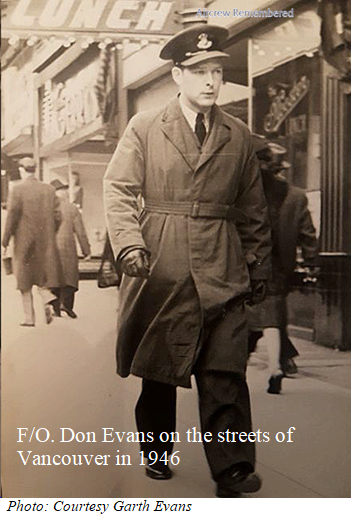
On 25 November 1946 he married Grace Marie Towle at Winnipeg Manitoba.
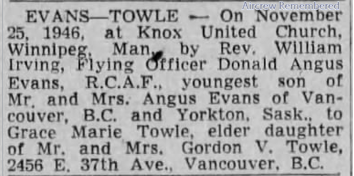
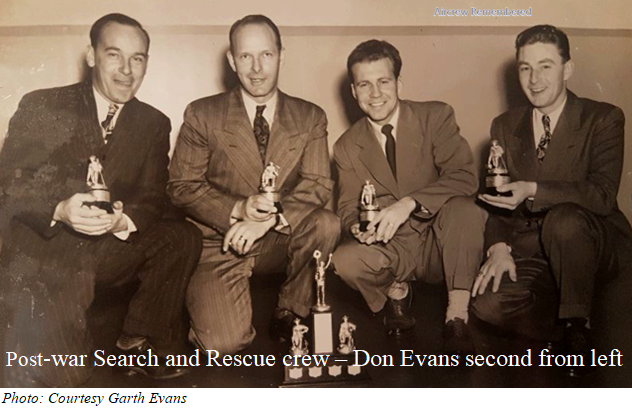
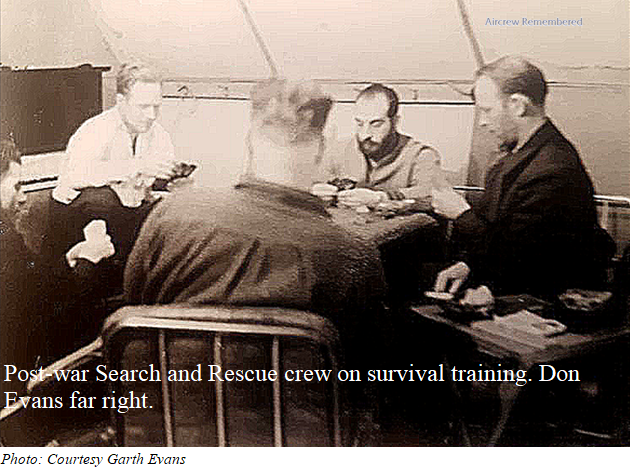
Don Evans and the above crew members flew together as part of the Arctic Search and Rescue Squadron based in Winnipeg from 1946 to 1949. Don was transferred in May 1949 and the others died in a plane crash the next month.
Donald Angus Evans died on 11 February 2006 at Burnaby British Columbia and was buried on 17 February 2006 at Mountain View Cemetery, British Columbia
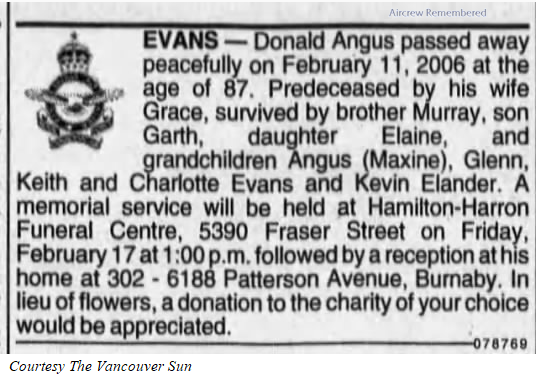
4. F/O. John S. Kingston from Toronto, Ontario, Canada. If you have any further information please contact our Helpdesk
5. F/Sgt. William Stewart from Glasgow. If you have any further information please contact our Helpdesk
6. Sgt. John C. Crawford was born on 3 August 1922 at Parksville, British Columbia, Canada the son of David Muir Crawford and Jane (Jean) Farquhar Crawford nee Lockhart. He had one sibling: Charles James Crawford (1923-1969)
Married to Marjorie E. Crawford (1921-1997)
He died at Tacoma, Pierce, Washington USA on 12 October 2007 aged 85, and was buried at Mountain View Memorial Park at Lakewood, Pierce County, Washington.
7. Sgt. William A. Waldram
Probably William Arthur Waldram born 1925 at Nottingham the son of William Arthur Waldram and Kathleen Elizabeth Waldram nee Taylor. He had three siblings: Horace James Waldram 1918-1956, Kathleen Waldram 1920-1995 and George Edward Waldram 1928-2006
The family later emigrated to Canada arriving at Quebec on 14 November 1932.
William Arthur Waldram died in Canada on 3 April 1996
Memorial at RAF Metheringham
placed by the son of the Pilot F/O Gordon S. Mather in 2003

BURIAL DETAILS
ME789: Nil, the entire crew survived.
AUTHOR’S NOTES
I am grateful to Dale Stogryn and Tony Soda for introducing me to Garth Evans who provided me with the opportunity of compiling this archive report on his father and his crew, including the sidebars on W/C Bill Deas and the loss of ND688 and MZ422.
The July 7/8 1944 bombing raid on the V1 storage caves at Saint-Leu-d’Esserent exemplifies the absolute unpredictability and vagaries of aircrew chances of surviving a tour of thirty ops.
During this bombing attack Lady Luck waved her magic protective wand over many and totally ignored those less fortunate. It was remarkable that the Vaires force taking a separate southern routing escaped unscathed. However, the Saint-Leu-d’Esserent force would not fare as well. The intellect and intuition of the German controllers were not deceived by the northern diversionary ‘spoof’ nor the Vaires force. Forewarned by the July 4, 4/5 raids on the St. Leu caves and the fact that they were still accessible, could only mean repeated attacks until they were neutralized. Moonlight conditions were essential for accuracy of marking and bombing, despite the nightmare of night fighter infiltration of the bomber stream. With the threat of V1 weapons to southeast England there really was no option, this target had to be destroyed at all cost. And the cost was sobering, twenty nine Lancs, two Mossies and their crews. It is impossible to comprehend how one bomber squadron (106) suffered the loss of five of its detailed crews and another (630) only one aircraft and crew, that literally ripped the heart of the squadron with the loss of their Commanding Officer and Engineering, Bombing and Signals Leaders. One can only imagine the sombre mood on the morning of July 8, 1944 in the messes of these two Squadrons.
Unfortunately, the 322 BG attack on Chateau de Ribencourt suffered a fate just as catastrophic as the Saint-Leu-d’Esserent raid with a 25% loss of aircraft detailed. One would have expected that with the timing of this raid that the majority of night fighters would have been forced to refuel. This was not the case and the German controllers were again up to the task, vectoring their Tame Boar crews into the American bomber stream, with deadly effect.
However, all was not lost and the target was rendered inoperative until overrun by Allied ground forces. Despite lessons learned from previous catastrophic raids including Nuremburg, Mailly-le-Camp and Vierzon it was not always possible to thread the needle, eluding the deadly threat of the Nachtjagd.
Routing no longer included protracted legs over Occupied Europe or orbiting assembly beacons marked by flares in moonlight conditions. However, the moon was an ally to be put to advantage optimizing marking and bombing accuracy. It was a calculated risk that necessitated clockwork timing to minimise the bomber stream exposure over the target. If all went according to plan, loss rates could be held at 5%, if not they could balloon to greater than 10%. The Saint-Leu-d’Esserent raid fell into the latter category due to the attempt to target the same objective within four days and the astuteness of the German controllers. As a result of this raid many British civilians would live, as many Bomber Command airmen paid the ultimate price.
In the photograph of W/C Deas one can appreciate the effect of the emotional strain of two tours of ops. It is ironic that a seasoned veteran should fall to a rookie Nachtjagd crew. Such was the fickle finger of fate. On account of the complexities of the loss 0f Lancaster ND688 captained by W/C Deas, it was considered more expedient to treat the story as a separate entity. To read the archive report please click here
By contrast, Wally Upton exemplifies an enriched, mature life that the remainder of ND688’s crew would never experience — as all the bomber boys who failed to return.
One bright star from this raid was the fate of the crew of Lanc ME789, with the entire crew surviving. For them the war was over. Gone was the chronic stress of Russian roulette with each op. Six would be confronted with the challenging hardships of captivity and the chaotic uncertainty during the final months of the war. F/O Don Evans was fortunate to experience the relative ‘luxury’ of an evader and early liberation. He was most grateful to the Labard family for risking their lives in the process of securing his.
THE MOON: FRIEND OR FOE?
The moon to many is symbolic of love and infatuation - moonstruck. To Bomber Command aircrew it had a much more sinister connotation—death by moonlight. A bomber pilot’s refuge was the inky cloak of night or the moist cocoon of cloud. In the event of a witnessed night fighter attack, the standard evasive manoeuvre was the corkscrew into the direction of the attack, to increase the angle of deflection for the fighter. It was customary to repeat this action until visual contact was lost with the attacking aircraft.
Description of Corkscrew Manoeuvre
Unfortunately, bomber crews were not aware that Nachtjagd aircraft were equipped with a deadly combination: SN2 Airborne Interception (AI) radar and Schräge Musik, usually two 20 mm canons mounted at the rear of the cockpit ( Bf 110 G-4) or mid-fuselage (JU 88 G-4/6) to fire near vertically. In effect this gave the Nachtjagd pilot the advantage of night/in-cloud vision and the ability to deliver an attack from the blind ventral position. Consequently this negated the corkscrew as an evasive manoeuvre with the fighter maintaining radar contact, resuming the attack once the unsuspecting bomber had returned to a steady course home. During my research I encountered two occasions when this manoeuvre maintained by a skilled Lanc driver saved the crew’s lives. 625 Squadron’s pilot, 1st Lt Max Dowden flying Lancaster LM513 on 30 March 1944, whilst returning from Nuremberg and after three successive night fighter attacks, elected to corkscrew continuously for the next hour! As a consequence, near fuel starvation forced him to perform a wheels down, off-airport procedure in the English countryside. All crew survived unscathed! 635 Squadron’s S/L ‘Baz’ Bazalgette VC DFC, during the 25 July Stuttgart raid, was forced by intense fighter activity to fly this evasive manoeuvre all the way back, resulting in a most memorable, unnerving ride for the rear gunner (see Lancaster ND811)
Theo Boiten recounts the chilling combat report of Ofw. Helmut Bunje that would have curdled the blood of any bomber crewman. During the course of the 14/15 February night raid on Chemnitz, Ofw. Bunje established visual contact with a ‘Lancaster’ that dived for cover into thick cloud. Unfazed, he followed suit homing on his SN-2 contact to within 200 metres. Inching forward to the point of near collision, established visual contact and raked the ‘Lancaster’ with a devastating salvo. During his evading manoeuvre, a crewman from the now blazing bomber flashed past above them.
The crew of 427 Squadron Halifax, MZ422, had no idea what had hit them - in the dark of night, cloaked in a protective cloud! Incredibly, this interception was witnessed on radar by Ofw. Bunje’s squadron mate Peter Spoden, who was stalking the same target 200 metres behind him when he saw flames and suddenly two returns on the radar screen, one dropping vertically and the other maintaining level flight!
Remarkably, the all Canadian crew of MZ422, piloted by F/O Vernon Shillington Roy, had three parachute to safety becoming POWs for the next two chaotic months before war’s end: Sgt. A.L. Morrison RCAF R198441, bomb aimer; F/Sgt. A.R. Williams RCAF R196508, navigator and Sgt. H.L.G. Mayer RCAF R225219, flight engineer. Sadly, pilot, F/O Roy RCAF J86214, mid-upper gunner, Sgt. Adolph Joseph Cybulskie RCAF R279178, and rear gunner Sgt. Harold Gallagher RCAF R274861 were found dead at the crash-site. Wireless operator, F/Sgt. Alden Norman Scorah RCAF R187219 was found seriously injured and subsequently died in hospital on 14 February 1945.
See below for burial details of the crew of Halifax MZ422
Moonlight conditions played a critical role during the March 30/31 1944 Nuremburg raid, dubbed by Martin Middlebrook as “The worst night of the war”. Forecast high cloud did not materialize, confronting the crews with clear skies, a half moon and vivid condensation trails at altitude - a nightmare! The 265 mile straight outbound leg, threaded between two night fighter beacons, was described as a brightly lit highway, with a centreline of flaming wrecked bombers and lit from above by the moon and fighter flares. Over this leg and the short dogleg to the target a total of 82 heavy bombers were destroyed! With the setting of the moon and rising of the sun, the grim total loss was 108 aircraft, a staggering 13.6% loss rate! In retrospect this raid should have been cancelled by the Chief of Bomber Command. One of the rare blemishes of a stellar three year career. 625 Squadron would lose W5009 with S/L T.M. Nicholls and crew. No. 101 Squadron, based at Ludford Magna, would lose a mind numbing seven of twenty-three aircraft detailed to participate in this op - 30% loss rate!
The weather forecast for bombing attack of 3/4 May 1944 on the military depot at Mailly-le-Camp was perfect for the precision required; clear skies, good visibility and a three quarter moon. An ‘overkill’ bomb load was to be delivered by 346 Lancasters from twenty squadrons to destroy a target that covered nine square miles! The complex plan included two waves of aircraft, orchestrated by three separate Master Bombers with three aiming points. In the event that there was a delay pilots were briefed to orbit an assembly point, marked on the ground by a yellow flare ten miles north of the target. For this raid to be successful everything had to proceed like clockwork. Unfortunately, nothing did.
At the opening of the raid a communication failure between the Master Bomber and the first wave resulted in a bottleneck over the assembly point that resulted in a five to twenty minute delay, that the Nachtjagd crews did not hesitate to capitalise on. This was one of the rare times that the rule of strict radio silence broke down as frustrated Skippers vented their frustration, without reservation. In the heated battle between the assembly point, target and the French coast, forty-two (12%) of the Lancs would be shot down. Master Bomber W/C Leonard Cheshire, realising the horrific loss of bomber crews, attempted to abort the raid, only to be thwarted by a communication failure! 625 Squadron would lose three of its aircraft on this raid, including Lancaster ME697 with S/L R.W.H. Gray and crew.
It is noteworthy that just prior to the Mailly-le-Camp debacle, Bomber Command senior staff, decreed that ‘milk run’ ops over Occupied Europe would count as only one third of an op. Post raid a near mutiny by aircrew forced this order to be rescinded. Sadly in the brief interim several crews were bound to fail to return from their thirtieth, thirty-second and third raids.
On 10/11 June 1944, 432 aircraft (323 Lancasters, 90 Halifaxes and 19 Mosquitos) were detailed to attack railway marshalling yards at four French cities, Achères, Dreux, Orléans and Versaille. Initial weather was a cloudless, clear dark and moonless sky. The Achères force including eighteen 625 Squadron aircraft was engaged by the Nachtjagd Tame Boar crews over the target. Lt. Walter Briegleb would claim four heavies in seventeen minutes, including two 625 Squadron crews, LM139 and possibly ND742.
For reasons unknown the Nachtjagd controller at 01.30 ordered his crews to the south of Rouen, informing them that the bomber force had cleared the French coast, when in fact all four forces still had thirty to forty-five minutes of flying time—with a rising three-quarter moon! Lady Luck held court and ruled in favour of Bomber Command aircrew. The battle was over, another blood bath by moonlight averted.
From the four forces, Bomber Command would lose fifteen Lancasters and two Mosquitos, 4%. 625 Squadron would have three aircraft failing to return (including LL897) of the eighteen detailed (17%)! However, worse was yet to come.
On June 30/July,1 1944 a force of 118 Lancasters were tasked to attack the railway yards at Vierzon. This was achieved with great accuracy despite a severe mauling by the Nachtjagd in conditions of bright prevailing moonlight. The bomber stream was over France for 54 minutes as the Nachtjagd crews were sent on a wild goose chase by their controller. It was not until 01.03, three minutes after the attack commenced, that the first bomber was brought down by a night fighter. For the initial 140 kilometres of the homeward leg the bomber stream was under constant attack. One Lancaster was attacked by a Ju88, ten times in forty-three minutes!
Once the dust had settled, fourteen Lancs failed to return, almost 12% of the attacking force. 625 Squadron would pay dearly with the loss of three aircraft and four crews: PB126, JB743, ND459 and ND975 (SDF) - 20% of the twenty aircraft detailed!. Over the eighteen months operational history of the Squadron, the Vierzon raid would prove to be the most costly, akin to the Saint-Leu-d’Esserent raid for 106 Squadron.
There can be no doubt that the moon was an added, deadly foe for Bomber Command crews. JEA.
Halifax MZ422 - Burial details

1. F/O Vernon Shillington Roy, age 27. Died on February 14, 1945.
Buried at Berlin 1939-1945 War Cemetery, 2.L.2 Germany
Son of Arthur V. and Olive M. Roy, of Napanee, Ontario, Canada.
His inscription reads:
Greater love
Hath no man than this
That a man lay down
His life for his friends
5. F/Sgt. Alden Norman Scorah. Died on February 14, 1945.
Buried at Berlin 1939-1945 War Cemetery, 2.L.4 Germany
6. F/Sgt. Adolph Joseph Cybulskie age 19. Died on February 14, 1945
Buried at Berlin 1939-1945 War Cemetery, 2.L.3 Germany.
Son of Victor and Rose Cybulskie, of Wilno, Ontario, Canada.
His inscription reads:
Eternal rest
Grant unto him, O Lord;
And let perpetual light
Shine upon him
7. F/Sgt. Harold Gallagher Died on February 14, 1945.
Buried at Berlin 1939-1945 War Cemetery, 2.L.1 Germany.

In response to an enquiry by Jack Albrecht, querying the date of 20.2.45 shown on the grave marker of F/Sgt. Scorah, the Commonwealth Graves Commission have confirmed that the date of death was in fact 14 February 1945 and the date on the grave marker was the date of burial.
REFERENCES:
Garth Evans Family Collection
The Bomber Command War Diaries, Martin Middlebrook and Chris Everett
The Nachtjagd War Diaries Volume Two, Theo Boiten and Roderick MacKenzie
Commonwealth War Graves Commission Website
630 Squadron Website
CO-AUTHORS:
John Naylor
Maureen Hicks
Reg Price DFC
Mike Edwards
Roy Wilcock (Aircrew Remembered)
Submission by Garth Evans and Jack Albrecht
RW/JEA/GE 28.01.2021
RW 22.10.2023 Bio and other details re Gordon Mather added, courtesy Ralph Snape